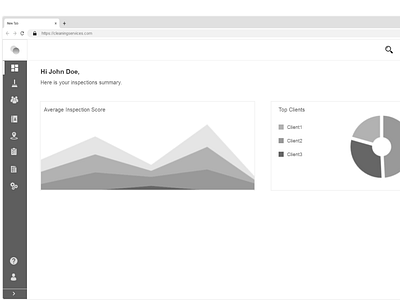Link - https://8an0p5.axshare.com/#g=1&p=company_admin&c=1
The UX Design Process
As a UX designer, I have been often asked “What process do you follow when designing apps and websites?”
A solid and well-executed UX design process, makes it possible to craft amazing experiences for users. The first thing that I learned as UX Trainee was the concept of Design Thinking. A solid and well-executed UX design process, makes it possible to craft amazing experiences for users. While working on multiple projects, each of a different nature, I have picked out the most essential phases and made this process a standard practice to be followed.
About The Project
Brief: To design a web platform for maintaining and cleaning big facilities like offices, buildings, skyscrapers, hospitals, hotels. To keep track of the inspections done by the employees of the company so that the building/facility is clean and provides a welcoming environment. The product has to be intiutive and easy to use.
Total project time: 10 Months
Role : UX Designer
My Design Process
1. Product Definition
2. Research & Analysis
3. Design
4. Validation
Product Definition
In this step we understood the product and its context for existence. This phase sets the foundation for the final product. At this stage, we (UX designers) brainstorm around the product about the concept of the product with key stakeholders.
This phase usually includes:
a) Stakeholder interviews(to gather insights about business goals)
b) Value proposition mapping( what the product is, who will use it, and why they will use it)
During this phase, we were able to understand how GDI Cleaning Services is different from other cleaning service providers. This Inspection tracking system had additional features like Report management, Work Order Management and Scheduling Calendar.
Research & Analysis
Once the idea is defined, the next phase is the research phase. This phase typically includes both user research and market research.
The product research phase is probably the most variable between projects—it depends on the complexity of the product, timing, budget, available resources, and many other factors. This phase can include:
a) User Interviews(provide qualitative data about the target audience, such as their needs, wants, fears, motivations, and behavior)
b) Competitive research(helps to understand industry standards and identify opportunities for the product)
Drawing insights and prioritization of key elements is the next step.
This includes:
a) Creating user personas(realistic representations of target audience)
b) Storyboarding(story about a user interacting with the product)
Some of the questions I asked in the User interviews were:
- What major problem would you like to solve while using this product?
- What other products have you tried out?
- What do you like/ dislike about the other product?
Design
Once users pain points, needs, and expectations from a product are clear, we move to the design phase. At this step, product teams work on various activities, from creating information architecture to the actual UI Design. An effective design phase is both highly collaborative and iterative in nature.
The design phase includes:
a) Sketching(fastest way to visualize ideas - drawing by hand on a piece of paper, on a whiteboard, or in a digital tool. It’s very useful during brainstorming sessions because it can help the team visualize a broad range of design solutions before deciding which one to go with)
b)Creating wireframes(to help visualize the basic structure of a future page, including the key elements and how they fit together and is used as a foundation for mockups and prototypes)
c)Creating prototypes( A prototype is like a simulation of the product - how each element works and interacts in the system)









